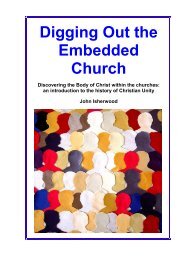Christian Unity (the book) - The Maranatha Community
Christian Unity (the book) - The Maranatha Community
Christian Unity (the book) - The Maranatha Community
Create successful ePaper yourself
Turn your PDF publications into a flip-book with our unique Google optimized e-Paper software.
just before death, <strong>the</strong>y might receive <strong>the</strong> consolamentum. Catharismconducted a sort of parallel church experience, with prayers and hymns, acommunal meal and a breaking of bread to take <strong>the</strong> place of <strong>the</strong> Mass.Catholicism had become remote to many ordinary worshippers, with a sort ofsecret religion conducted in <strong>the</strong> sanctuary in an alien language. A bro<strong>the</strong>rhoodof suffering existed among <strong>the</strong> Cathari, and a kiss of peace and a sermon inone’s own language contributed to <strong>the</strong> sense of belonging to a pure andspiritual people.Yet <strong>the</strong> Cathari were heretics. <strong>The</strong>ir rejection of <strong>the</strong> authority of <strong>the</strong> Church;<strong>the</strong>ir use of <strong>the</strong> vernacular in worship and preaching; <strong>the</strong>ir dualism andheterodox, docetic views of <strong>the</strong> Person of Christ; and <strong>the</strong>ir rejection of <strong>the</strong>belief in <strong>the</strong> resurrection of <strong>the</strong> body, meant that <strong>the</strong> essential elements ofCatholic <strong>Christian</strong>ity were denied.<strong>The</strong> growing link between <strong>the</strong> Church and <strong>the</strong> State made it inevitable tha<strong>the</strong>resy in <strong>the</strong> Church was seen to be inimical to <strong>the</strong> health of <strong>the</strong> State. <strong>The</strong>Church began to look to <strong>the</strong> State to punish those she declared to be heretics.In 1022 Robert of France had 13 Cathari burned at Orleans. Not only was <strong>the</strong>Church as an institution outraged by heresy, but ordinary Catholics felt <strong>the</strong>offence, too.In 1114 in Germany, mobs dragged some heretics from prison and burned<strong>the</strong>m. On more than one occasion clergy rescued heretics from lynch mobs.<strong>The</strong> Second Lateran Council 39 of 1179 commended <strong>the</strong> punishment of hereticsby secular bodies. In 1184 Emperor Frederick Barbarossa put all heretics under<strong>the</strong> ban of <strong>the</strong> Empire 40 so that heresy came to be seen as a kind of treason.Executions of Cathari, usually by burning, lasted for <strong>the</strong> best part of 200 yearsin Europe. With <strong>the</strong> Bogomils (lovers of God), ano<strong>the</strong>r Cathari-like sect from39<strong>The</strong>re was a series of Church Councils which met in <strong>the</strong> Lateran Palace, in Rome between<strong>the</strong> 7 th and 18 th Centuries. <strong>The</strong> most important was <strong>the</strong> 4 th Lateran Council under InnocentIII, at which <strong>the</strong> doctrine of transubstantiation was declared to be <strong>the</strong> truth about <strong>the</strong>Eucharist and yearly confession to a priest was required of all <strong>Christian</strong>s.40<strong>The</strong> ban of <strong>the</strong> Empire. As well as Lu<strong>the</strong>r being excommunicated from <strong>the</strong> Church by Papaldecree, <strong>the</strong> newly elected Emperor, Charles V, as <strong>the</strong> Church’s secular custodian, put himunder <strong>the</strong> ban of <strong>the</strong> Empire by <strong>the</strong> Edict of Worms, 26 May 1521. By this Edict Lu<strong>the</strong>r wasbanished from <strong>the</strong> lands of <strong>the</strong> Empire (and was hidden for his safety by friends for a whilein Warthburg Castle), and wherever his writings could be found <strong>the</strong>y were to be burned.Page 54








